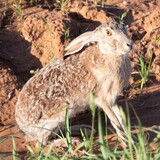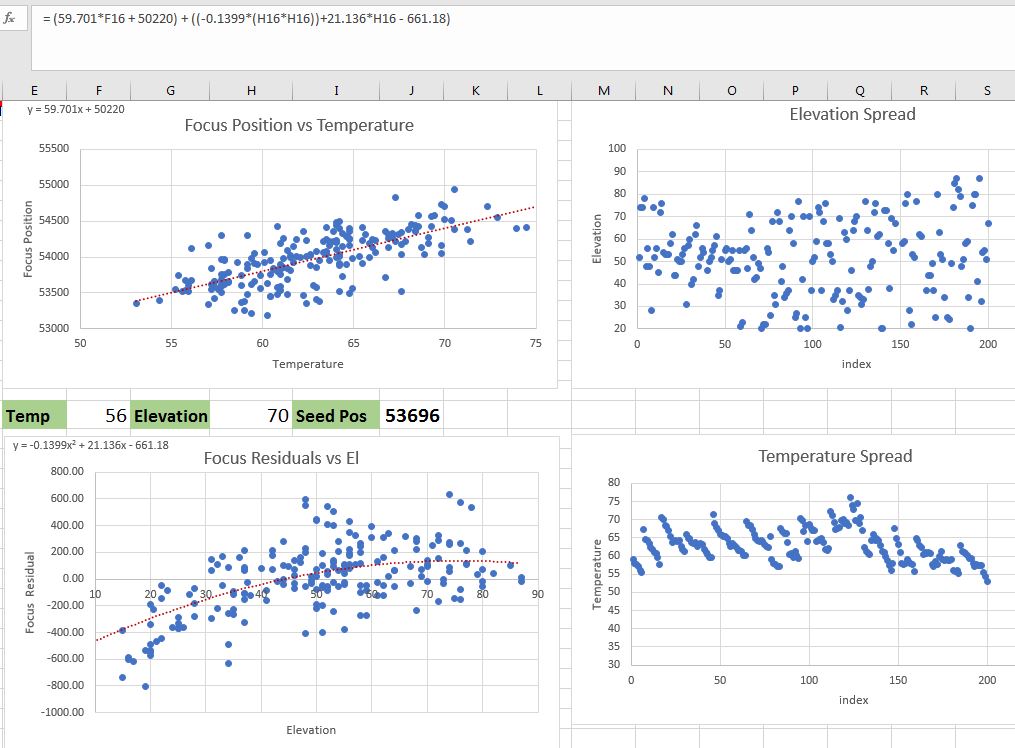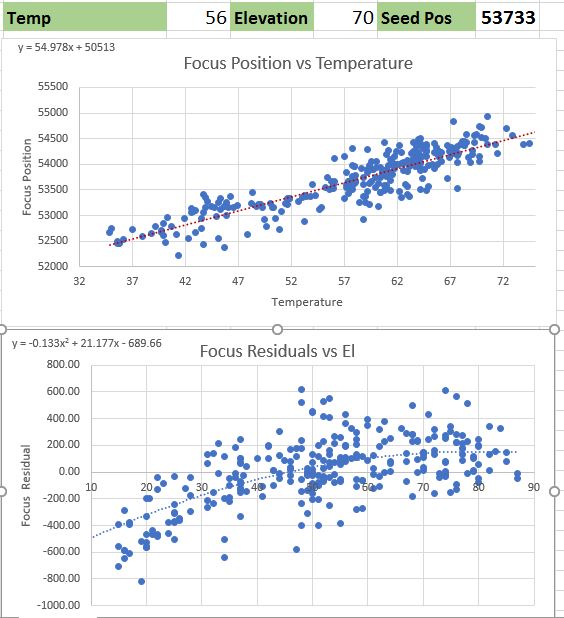INDI Library v2.0.7 is Released (01 Apr 2024)
Bi-monthly release with minor bug fixes and improvements
Temperature and Altitude (residual) focus compensation
Replied by Andrew on topic Temperature and Elevation focus compensation
Please Log in or Create an account to join the conversation.
Replied by Doug S on topic Temperature and Elevation focus compensation
Edit: I've updated the charts for my setup (updated in the OP). There are ~300 autofocus sequences captured from July to Nov. Based on the results, I've altered the elevation residual function to a 2nd order poly (still not quite powerful enough...but sufficient). The temperature function dominates (5 degree change drives ~400 focuser count shift), while elevations above ~40 degrees do not really drive noticeable offsets. Observations below 40 degrees elevation do drive significant offsets. Your gear & results will differ, but the trends will likely be similar.
Cheers, Doug
Please Log in or Create an account to join the conversation.
Replied by Giles on topic Temperature and Elevation focus compensation
It's excellent as it is, but always thinking of better. I know the team are making loads of commits to get 3.5.0 stable, but this would make a worthy future feature.
Please Log in or Create an account to join the conversation.
Replied by Doug S on topic Temperature and Elevation focus compensation
I'll make the bold statement that temperature and elevation focus compensation could benefit everyone who takes the time to characterize their gear (via the existing focus log entries). This is especially true for faster focal ratio setups. I've seen the difference, and it's appreciable. Updating the focus position (seed) before starting autofocus always results in a minimized,symmetric V curve. I no longer worry about donuts or run-away anomalies, and focus updates are more efficient. For scheduled or remote/unattended observations, I would think this would especially add robustness and less overhead.
So, I'd like to ask if there's someone from the core developers who might want to partner with me to resolve final details, and modify the focus code for a future release. I've never been a GUI developer. I can definitely drive requirements and help with coefficients file logic and seed update logic. The GUI work should be minimal (enable switch for compensation seed auto-update). A minimalist approach now could be followed later with more sophisticated automation. Comments? Any takers? Thanks, Doug
Please Log in or Create an account to join the conversation.
- Brian Davis
-

- Offline
- Junior Member
-

- Posts: 33
- Thank you received: 15
Replied by Brian Davis on topic Temperature and Elevation focus compensation
Please Log in or Create an account to join the conversation.
Replied by Doug S on topic Temperature and Elevation focus compensation
Please Log in or Create an account to join the conversation.
- Brian Davis
-

- Offline
- Junior Member
-

- Posts: 33
- Thank you received: 15
Replied by Brian Davis on topic Temperature and Elevation focus compensation
3. Changes in the HFR outside the expected due to step movement show up as residuals (error) in the measured HFR, forcing the measured points to fall outside the polynomial used to determine best focus.
4. Temperature, pressure, humidity. dust, in the air volume the light passes through, all change the refraction of received light, with temperature and density (pressure) being the primary factors in changes in refractive index (and thus changes to the measured radii of stars)
What I don't know, is the size of the HFR errors produced by refraction at 40 degrees and below, or their stability and how they compare to the data you've gathered here, or the extent to which the programmer factored it into to the focuser tools, but given the parameters you've listed, I'd be surprised if it wasn't the main driver.
None of this argues against what you're suggesting. The data gathered might be useable for determining a "calculated delta focus from polynomial prediction" factor which could in turn be used to produce a better seed guess, step size guesses, etc. A feedback loop to improve accuracy is what you're suggesting, correct?.
Please Log in or Create an account to join the conversation.
Replied by Doug S on topic Temperature and Elevation focus compensation
The refraction graph is about as I expected. The change from 40 to 25 degrees is on the order of an arcmin POSITION. Colors refract differentially, so we'd expect HFR to increase perpendicular to the horizon. Whether refraction or airmass is the major driver, I consider elevation to be a good proxy for modeling/controlling the effect (and it's readily available).
re: "A feedback loop to improve accuracy is what you're suggesting, correct?"
The original post was intended to get folks thinking about temperature and elevation focus compensation as an approach to more robust focus management. I suggested that minimally, temperature would be an improvement, and that temp and elevation residuals would be an even better improvement. A GUI control might be as simple as allowing pre-seeding the focuser position before autofocus, or as complicated as allowing autoupdating of focus position before each subexposure. Having manually updated the seed for ~200 autofocus runs myself, I know this approach is better than blind autofocus runs (especially at the start of night when temps are moving fast, and at any time during the night when big changes in elevation are made as a result of slews). There's a good reason why many large observatories employ "active optics control". Temp and el focus compensation are a big part of that concept. There's no reason why we shouldn't have access to this concept too. For slow configs, it might not matter much, but for fast configs, it keeps efficiency high.
Please Log in or Create an account to join the conversation.
- Brian Davis
-

- Offline
- Junior Member
-

- Posts: 33
- Thank you received: 15
Replied by Brian Davis on topic Temperature and Elevation focus compensation
It's not a position graph, it's a graph of the Index of refraction versus the elevation angle at standard temperature and pressure (STP). It is a number representing the angular displacement of incident light rays through the atmosphere showing the effect of thickness of the transited airmass between the observer and the celestial target. The calculated index is directly influenced by temperature and pressure (among other things, but these are the two largest factors), Elevation angle is a scalar value, and it's change due to earth rotation, is based on the location data, which doesn't change (or shouldn't)., so it has no mathematical relationship to temperature, and isn't a proxy value for anything. Unless your mount is on a moving object, it will not have have a direct impact of tracking error, unless .
Temperature has several effects. It causes the materials in the mount or gear to expand or contract, which can change the elevation angle slightly, and the error it produces will be relatively constant, and always in the same direction relative to the direction of the temperature change. So you wouldn't expect to see a lot of tracking error scattered about the regression line, instead you'd see the directrix of the parabolic regression line move up or down the Y axis, but the parabola itself doesn't change its shape.
The principle effect of temperature changes is that they change the index of refraction (RI), and thus change the apparent size of celestial objects. If the atmosphere were still and well regulated, then this wouldn't be a problem, but it isn't. It roils, changes density, and the stratification of the air changes, and this produces inherent error in the RI, and that translates directly to focusing, tracking and guiding errors, and those will be randomly scattered about the calculated RI.
In your post, you refer to Temperature Compensation as though it is a single term, but it's not. It's an ephemeral value calculated specifically for each value modified. There is no one "Temperature Compensation" value. Theres one for refraction, one for expansion/contraction, and probably others. A programmer would have to discuss how they used temperature in the various processes, to discuss it in more specific terms, but the main takeaway, is that temperature compensation is only a meaningful term when it includes the process or value being compensated. It will be different for every process.
It's not. The elevation is fixed (or should be) and does not change during a session. It is used for the initial calculation of the RI (and alignment, etc), but thereafter is constant, and so has no further effect on focusing or focus error. RI, on the other hand, continuously changes, and has a direct and pronounced effect of focus error.
Please Log in or Create an account to join the conversation.
Replied by Bart on topic Temperature and Elevation focus compensation
Also, if you take refraction into account, will you then -not- take it into account when using narrow band filters? There the effect isn't measurable.
Now a question, would you consider to focus during imaging or quickly adjust the focus in between lights?
Personally, I don't use very long exposure lights, especially with Starlink up and screwing up our images.
Please Log in or Create an account to join the conversation.
- Brian Davis
-

- Offline
- Junior Member
-

- Posts: 33
- Thank you received: 15
Replied by Brian Davis on topic Temperature and Elevation focus compensation
Elevation usually refers to the geographic distance from the earths center, most often expressed as altitude above sea level. What you're referring to is most often called the zenith angle, or the angular displacement from zenith.
The Refractive Index applies to all electromagnetic radiation. It is usually calculated for yellow light for use in astronomy. However, the actual energy (frequeny and amplitude) of a received photon is an independent variable in the calculation for angular deflection produced by the refraction index.
I refocus on every 2 degree change in temperature, or guider crapout, or at the start of any sequence. Focus while taking lights isn't critical to the process, but shouldn't be changed between exposures.
Please Log in or Create an account to join the conversation.
Replied by Doug S on topic Temperature and Elevation focus compensation
My original post is simple: Two readily available variables in Ekos (temperature, (target) elevation=altitude) can be used to dramatically improve focus control. I've shown a relationship of temperature to focus. I've also shown that once factored, residuals of a temperature function can be correlated to target elevation. The data speak for themselves. Anyone who wishes can verify or refute the suggested relations by characterizing their own focus behavior via the focuser debug log. I am not stating that these two functions are the perfect and complete academic explanation. Rather, these two variables are readily available in Ekos, and serve particularly well to prevent poor auto-focus starting position, offset focus position between exposures, or prevent poor focus position after slews of large elevation difference. We're trying to remain close to the focus caustic. KISS can work well here. Cheers, Doug
Please Log in or Create an account to join the conversation.



